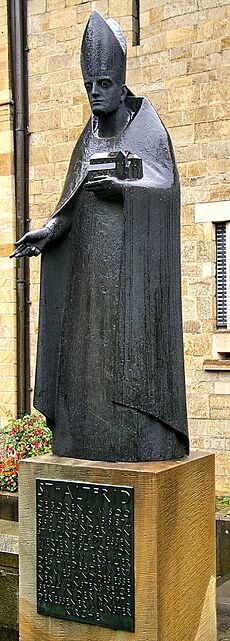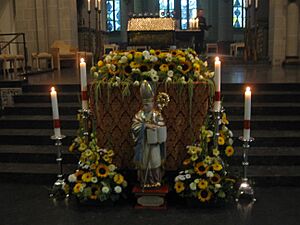Altfrid facts for kids
Saint Altfrid (also known as Altfrid of Hildesheim) was an important leader in Germany during the 800s. He was a Benedictine monk, which means he belonged to a religious order. Later, he became the Bishop of Hildesheim, a high-ranking church leader. He also founded Essen Abbey, a special religious community. Altfrid was a trusted adviser to King Louis the German, who ruled the eastern part of the Frankish kingdom.
He is considered a Roman Catholic saint. His special day, called a feast day, is usually celebrated on August 15th. However, in Essen and Hildesheim, it's celebrated on August 16th.
Contents
Altfrid's Life and Work
We don't have a biography of Altfrid written when he was alive. The first time his name appears in records is on October 3, 852. At that time, he was already known as the Bishop of Hildesheim and took part in a church meeting in Mainz.
The Hildesheim Chronicle, an old record, says Altfrid died in 874, having lived a long life. This suggests he was born around the year 800. He owned land in the Harz region and in central Essen. It's likely he came from a noble Saxon family.
Before becoming a bishop, Altfrid was probably a monk at Corvey Abbey. In 851, he became Bishop of Hildesheim after the previous bishop, Ebbo, passed away. Ebbo had been removed and reappointed as archbishop several times. To make sure everything was valid, Altfrid unusually chose to repeat all the blessings and ordinations Ebbo had performed.
Building Churches and Helping Others
In 864, Altfrid moved the bones (relics) of Saint Marsus from Auxerre to a place in Saxony, probably Corvey Abbey. He even gave a sermon when the relics arrived.
Altfrid also started building a new cathedral in Hildesheim in 852. This was a large church with three main sections and a cross-shaped design. It was finished in 872 and officially opened on November 1, 872. Four bishops and the Abbot of Corvey were there for the special event.
Even before he became a bishop, Altfrid helped set up several religious communities for women. Between 845 and 847, he brought the relics of Saints Cosmas and Damian from Rome. Altfrid also helped a Saxon count named Ricdag create the nunnery at Lamspringe. He did this by getting the relics of Saint Hadrian from Rome for them.
Founding Essen Abbey
According to the Hildesheim Chronicle, Altfrid also founded a Benedictine monastery on his own land in the Harz region. We don't know much about this monastery, like where it was or how long it lasted.
More importantly, Altfrid founded Essen Abbey on his property in Essen. The first leader (Abbess) of Essen Abbey was Gerswith, who was related to Altfrid. People often said she was his sister, but there's no clear proof. Altfrid built a small chapel in Essen, dedicated to Saint Quentin. This chapel was later taken down in 1817. He also built a larger church for the nuns, which became known as the Essener Münster. From 1958, it has been called Essen Cathedral.
Altfrid wished to be buried in this church after he died on August 15, 874. His tomb, built in the Gothic style, is in the east crypt of the cathedral, which is now named after him. Altfrid also founded Liesborn Abbey and a monastery for men in Osterwieck.
Altfrid as a Diplomat
Altfrid was a very close and trusted friend of King Ludwig the German. From 860 onwards, he played a big role in the power struggles between different parts of the Frankish empire, which was starting to break apart.
In 860, Altfrid was present at a meeting between Ludwig the German and Charles the Bald in Koblenz. Here, the two kings agreed to a peace treaty. Over the next few years, Altfrid traveled a lot. He was in many important places like Asselt, Compiègne, Savonnières, Pitres, Thousey, Metz, and Worms. Altfrid had a major influence on the Treaty of Meerssen. This treaty, signed on August 9, 870, divided the region of Lotharingia between West Francia and East Francia.
Death and Legacy
We don't know exactly where Altfrid died, but we know the date: August 15, 874. This was on the feast day of the Assumption of the Virgin Mary. As he wished, he was buried in the church of Essen Abbey.
After his death, people especially honored Altfrid at his tomb in Essen. Around the year 1000, stories of miracles happening at his grave became common. This greatly increased his fame. People also believed that a healing spring near the church had special powers because of Altfrid's prayers.
After a big fire in the church in the 1200s, a new sarcophagus (a stone coffin) was made for his bones. Altfrid's feast day was the most important celebration in the abbey's yearly calendar, celebrated on August 16th in Essen.
However, Altfrid was not officially made a saint by the church for a long time. When the abbey was closed down in 1803, people stopped honoring him as much. But during a time of conflict between the church and the state, called the Kulturkampf, his veneration became popular again. In 1958, when the Bishopric of Essen was founded, the first bishop asked Rome to officially confirm Altfrid's feast day as a church festival. This request was granted in 1965.
See also
 In Spanish: Altfredo de Hildesheim para niños
In Spanish: Altfredo de Hildesheim para niños



